GCR meets Greg Kloehn, the Californian artist who makes nice homes from waste to give to the homeless.
Anytime I see anything on the side of the road that looks appealing I pull over, grab it, throw it in my van. My studio looks like a big garbage pile but I play Tetris in my head – that would go with this, this would go with that, then I build it– Greg Kloehn
If you have to be homeless in America, California is a better place to be than most. For one thing it doesn’t get too cold, and for another the state is fabulously wealthy: its GDP is $2 trillion, about the same size as Russia’s, and the median family income is around $70,000.Â
This means that it produces a lot of good quality garbage, which can be used for both food and shelter.
The bad part is that cities in the state have done their best to make the homeless go somewhere else. Many now classify vagrancy as “camping in public” and have made it a punishable offence. Santa Cruz has gone further. There, it’s a criminal act to sit on a sidewalk.Â
Palo Alto has 15 shelter beds for a homeless population of about 150, but if any sleep in a car that they own, they can be sent to prison for six months.Â
In Oakland, the city just to the east of San Francisco, recent stats on homelessness are not easy to find. A 2013 survey prepared for EveryOne Home charity found that there were 4,264 homeless people in Alameda County, of which Oakland is the main city. An earlier study in 2004 identified 2,450 homeless adults and children in Oakland itself.
Whatever the exact number, businesses there have demanded that the city tackle the problem with tougher by-laws. “I need to put up a fence and manage my business like I’m an outpost in Afghanistan,” complained Judy Tavory, who runs a travel agency, to her local paper.
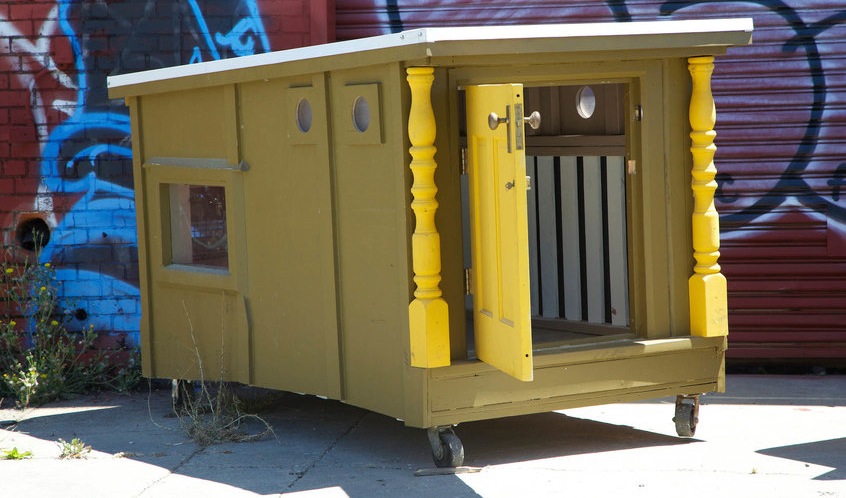
Some have wheels
Some have called on the city to follow the example of Fort Lauderdale, Florida and make it legal for police to appropriate a homeless person’s belongings, but illegal to set up an open air soup kitchen unless there are also portable toilets, hand-washing stations and measure to maintain food at specified temperatures.Â
Down and out in California
Regardless of the particular by-laws in force, dispossessing the dispossessed has never been difficult. If a homeless person makes a shelter it can be torn down and thrown away by municipal sanitation teams, because it isn’t protected by the US’s fiercely enforced property laws.
But the form that these shelters took caught the attention of Greg Kloehn, an artist based in Oakland, who had a longstanding interest in unconventional dwellings. He was working on a book about the lives of homeless people when it struck him that they really did have homes, it’s just that nobody, least all the city council, saw them as that.
“That opened my eyes to how the city would treat them, how they would scoop up their homes and throw them away,” he said. “I became enamoured of their tenacity – some of them are geniuses of tenacity, and what they build with garbage is a tribute to the human spirit. So then it was like, okay, man, I want in. I’ll make homes out of dumped garbage too, source my material where they do, see what I come up with.”
That gave him the refuse-refuge bug. “I’m driving around, and anytime I see anything on the side of the road that looks appealing I pull over, grab it, throw it in my van,” he said. “My studio looks like a big garbage pile but this is all my stuff and I play Tetris in my head – that would go with this, this would go with that, then I build it.” Â
$50 in cash
Kloehn has built about 30 homes now. He estimates that they cost around $30 to make, but he gives them away, prioritising those he judges are ‘lifers’, who’ve been on the street for 15 years or more. He prefers to give them to women because he feels women are more at risk on the street than men.
He also likes giving them to people who stick to a certain neighbourhood because he’s curious to see how the homes evolve.
Kloehn’s idea was to create homes from found objects using ingenuity rather than money. Of course, he had certain advantages over the homeless, including a minimal budget, a workshop and tools. “They haven’t got cordless drills and all that jazz, they just haphazardly lean these things together and throw a tarp over it,” he said.
The first home he built had a queen-sized box-spring mattress at the base, pallets for walls, an old fridge door for the door, and an old camper-van shell for the roof. It had almost everything a ‘normal’ home has, but in miniature: a little kitchen, a little bathroom, even a little electrical system. It even had a dog basket on the side.
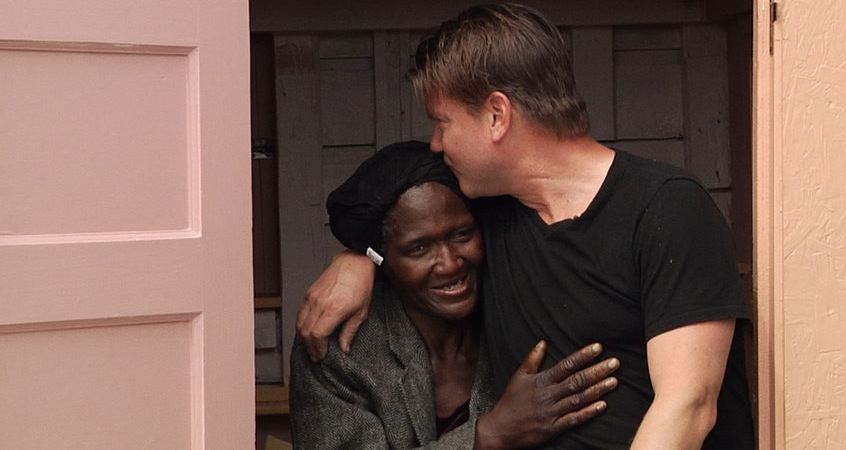
Kloehn prefers giving the homes to women because they are at greater risk on the street
“I like to see its progression, its little life, how it changes,” he said. “I don’t want it to be sold real quick. When I give it away, I say, hey, I’m giving it for free, I’m not asking anything, I just want you to live in it. If your situation changes, give it to someone who will live in it.”
That’s right – they do get sold, but such transactions are not likely to get their owners on the conventional property ladder. “One man sold his home for $50 in cash and $100 in crack cocaine,” Kloehn said. “Then I’m thinking, hey, where’s my cut?”Â
Form and function
The homes are meant to be sturdy: he said one was hit by a car and came away with nothing but a dent. Solid floors and roofs protect the homeless person from rats and rain.
Crucially, the homes have a door and a lock. Says Kloehn: “If you have a door and you have a domicile, the police need a search warrant to go in – if you have a tent, you have no rights.”
The lock also means freedom because without a secure place to store things, the homeless must carry anything of any value wherever they go.
But Kloehn insists on style and distinction as well – polished hardwood floors, atmospheric lighting, and columned porches have all featured in his creations. There are practical reasons for this, to do with the risks of living rough.
The appearance of care and artistry means the home has value, which offers some protection from it being dismissed as garbage and destroyed.
And however peculiar the beauty of a home is, it bestows some much needed pride of possession. “They take care of them because they know they’re going to have them for a while. They’re decorating them, they’re repainting them. One guy turned it into double one – he put a whole addition on and it looked real good.Â
“People are hanging artwork, painting murals on the side. I inspired another homeless guy and he’s breaking up pallets and making these nice outdoor beach chairs, and he sells them. I give him tools and I give him my scraps, couple of screws and he’s got a little cottage industry.”Â
Don’t play that game
The project has attracted publicity, and Kloehn has travelled around America giving workshops. The practice of building debris-domiciles has sprung up in other American cities, and even in Argentina, he says.
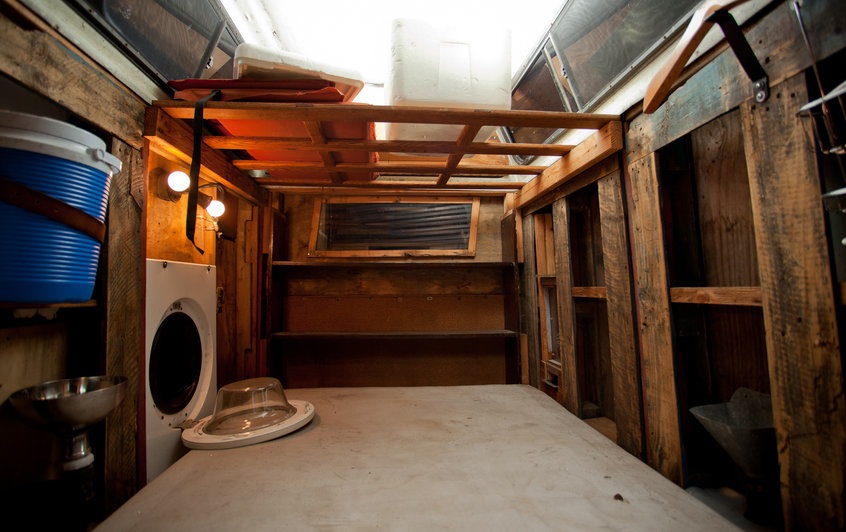
The first house Kloehn made out of garbage came with an electrical system and a bathroom
But he admits that he isn’t really a social entrepreneur or movement-starter. “I’m not real savvy with that – I don’t email much, I’m not out trying to fundraise. I don’t play that game. People say you should be making so much money, then I start reading all the legal work and I’m half a page into it and I’m like, forget it. You want to do it? You do it. I’ve got two kids, I’ve got a wife, things going on.”
The workshops can also be something of a trial. When only two out of 20 people know how to use the tools, the artistry goes out of it, he said. “This old lady wants to use the electric chop saw and I’m worried about her cutting her hands off, so it’s not quite babysitting but after doing so many workshops, it was like, you know what? I’m not having fun anymore.”
Much better, he said, would be a dedicated warehouse space where people can drop off materials and join in if they want, but where he’s more in control of the creative process.Â
Aiding and abetting
He can’t be bothered to start a movement, but it does annoy him that neither the city administration nor any of the main homeless charities has tried to connect with him. It’s probably because he is aiding and abetting life on the streets, and street life is something city authorities seem bent on wishing or legislating away.Â
In fact, there is evidence to suggest that Kloehn should be actively encouraged. In a study last year, the state of Utah’s Housing and Community Development agency calculated that housing just one chronically homeless person generated around $8,000 net cost savings to taxpayer-funded community systems.
A similar study in Florida concluded that giving homeless people permanent housing and case managers would save taxpayers $149m over 10 years in reduced law enforcement and medical costs.
But with municipal leaders under pressure to take a hard line on homelessness, Kloehn’s charitable art will be seen as subversive. This was confirmed when one woman whom Kloehn described as “high up in the building department” showed up for a workshop.
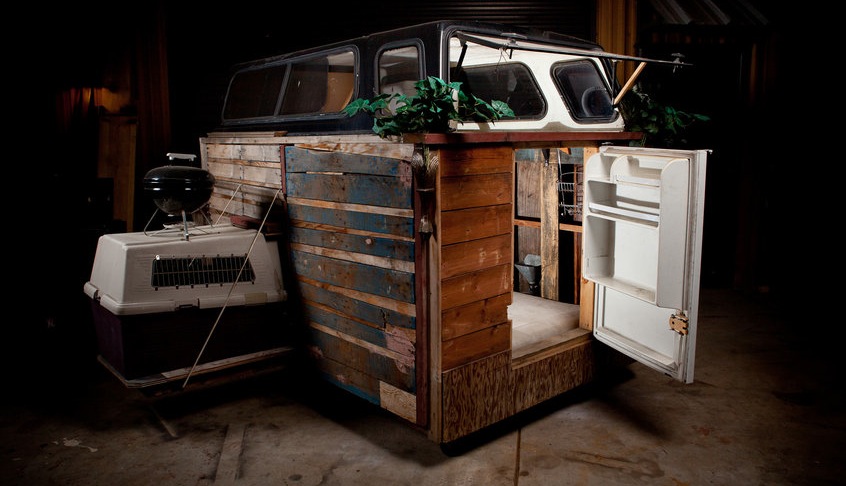
The first home even had a dog basket on the side
“She said don’t try to make it legal,” Kloehn recalls. “If you go to the city they’ll say, that’s a good idea, we’ll put that through our paperwork chain and, in the meantime, don’t build them anymore. They’d run me around. I don’t want to do that. They understand stuff but not people.”Â
Art and the taxman
Habitats of one form or another have been central to Kloehn’s career. At one point he almost found himself turning into a property developer.Â
He trained as a fine artist but really got his start when he took a few thousand dollars that his grandmother had left him and bought a fire-damaged property in an Oakland ghetto in 1999.Â
“At first I thought, hey, I’m going to invite my friends – we’re going to have some pizza, some beers, some hammers and we’re going to build this thing – we’re going to make this huge architopia.”Â
But pretty soon he realised that that’s not how property development works. The friends were keen on the pizza and beer but less so on the work. So he teamed up with a small developer and built some condos and a studio for himself.
His ship came in when the ghetto turned into a yuppie haven and the housing market came roaring back, giving Kloehn almost enough money to pay off his debts and take his family for a holiday in Hawaii – which is where it occurred to him that he’d forgot about the tax he’d have to pay.
Now it’s a matter of getting by while he plans the next project. He gets donations, which covers his costs but little else.Â
As an artist, though, he’s anything but finished with designing homes from waste.
“There are a couple of different types of homes I think about when I’m up at three in the morning,” he said. “I made a home out of a dumpster, and people said, oh, that’s cute, but when it comes down to it, it’s like oh, I can’t live in that.Â
“So now I’m going to build a model that you can live in – that you and your wife can come down and both say, we could do this. It would take a very special woman who would live in a dumpster, but there are different styles – maybe you could turn it into a B&B …”
Comments
Comments are closed.










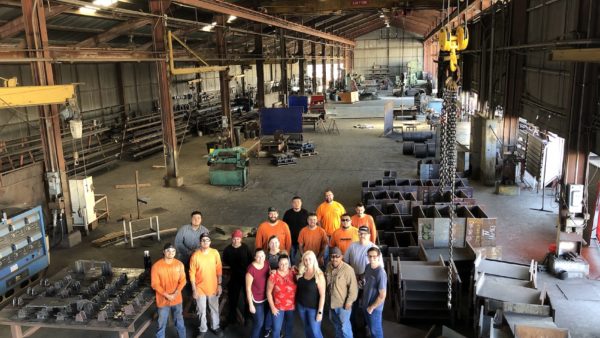
What a gentleman. He has give up his own time and resources for a genuine cause. What he builds and gives to the homeless means that they have an element of safety and security. All that is needed now is for the local cities to perhaps give a little bit of land to the homeless so they can site their new homes, put up a fence around for a bit of protection and shelter and then the homeless have a reason to live, not just survive. He didn’t set out for publicity, he just performed a good deed, well done.